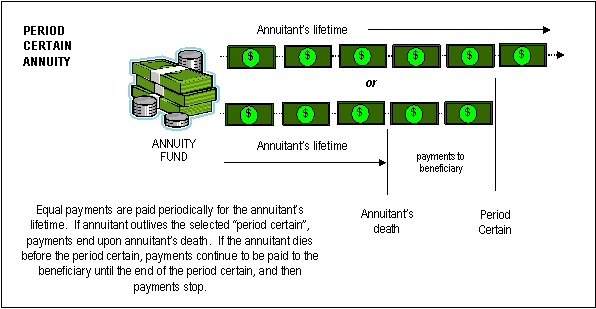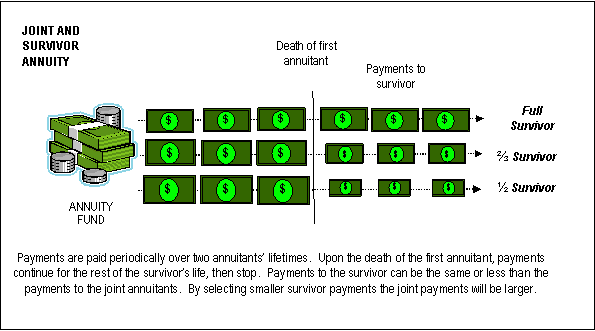|
Annuity Basics |
|
How long will annuity payments last?
Annuitants have numerous payout options. As mentioned earlier, the amount of each annuity payment is based on three factors: principal, interest and the length of the payout period. So the size of each payout obviously depends on the amount accumulated in the contract. In the case of lifetime payouts, the size of payments also depends on the life expectancy (or survivorship factor) of the annuitant. All other factors being equal, younger annuitants with a longer life expectancy will receive smaller annuity payments than a person annuitizing an equal amount at an older age. Likewise, women, who have longer life expectancies than men, will be paid smaller annuity payments (unless the company uses “unisex” survivorship factors.) Another factor the company will consider is whether the payout method provides for possible continued payments to a beneficiary. These payout options may extend the payout period past the annuitant’s lifetime and consequently result in lower periodic payments.
Please note that the size of future annuity payments is calculated when the account is “annuitized”. Deferred annuities typically offer the contractholder guaranteed minimum payouts at the contract's inception, but in many cases, the company will offer the contractholder more advantageous "current" payouts when the contract is actually annuitized. And as we'll see when we discuss exchanges later in this course, the contractholder can exchange the current contract for another contract that offers better payout options -- and then annuitize the new contract. Once the payout method is selected, the size of the income payments will not change in the future (or in the case of variable annuities, discussed below, the number of annuity units remains fixed).
Contractholders may choose among a number of annuity income options: straight life income, cash refund, installment refund, life with period certain, joint and survivor, as well as annuities for a specified period.
Straight Life Income Option
A straight life income annuity option (often called a life annuity or a straight life annuity) pays the annuitant a guaranteed income for his or her lifetime. When the annuitant dies, no further payments are made to anyone. If the annuitant dies before the annuity fund (i.e., the principal) is depleted, the balance, in effect, is "forfeited" to the insurer. The company will use the forfeited balance to provide payments to other annuitants who outlive their life expectancies. (Companies rely on “risk pooling” and the “Law of Large Numbers” when constructing annuity contracts -- just as they do when they underwrite life insurance.)
|
|||





|
Of all of the payout options, straight life pays the highest monthly income payments, all other factors being equal. This is because the insurance company has the possibility of retaining the “forfeited” funds under a straight life annuity. All of the following options provide for additional payouts to beneficiaries, and therefore will pay slightly lower monthly payments than the straight life option.
Cash Refund Option
A cash refund option provides a guaranteed income to the annuitant for life and, if the annuitant dies before the annuity fund (i.e., the principal) is depleted, a lump-sum cash payment of the remainder is made to the annuitant's beneficiary, Thus, the beneficiary receives an amount equal to the beginning annuity fund less the any principal payments made to the deceased annuitant. |
|
Annuities for a Specific Period
While lifetime annuities are a preferred method for paying out benefits, annuities can be structured for a specific number of years, rather than a lifetime. Indeed, this is how our discussion of annuity began. Structured settlements (legal judgments payable over time) and lottery prizes are examples of an “annuity for a period certain”. Any period is possible, with terms of 10, 15 or 20 years being common. At the end of the specified term, payments cease.
While it may seem obvious, contractholders who do not have a life expectancy may not select a lifetime payout. Contractholders such as corporations and charities must select an “annuity for a specific period”.
The following shows representative samples of annuity payout tables.
|
|
Joint and Survivor Options
The joint and full survivor option provides for payment of the annuity to two people. If either person dies, the same income payments continue to the survivor for life. When the survivor dies, no further payments are made to anyone. Payments may continue at the same level to the survivor, in which case the annuity is “joint and full survivor”. As you might imagine, this is a popular way for married couples to guarantee income for both spouses regardless of who may die first. Often, the couple might reason that living expenses will be less upon the death of one of the spouses. The couple might select a reduced payout for the survivor. “Joint and two-thirds survivor” payouts reduce the survivor's income to two-thirds of the original joint income; “joint and one-half survivor” plans reduce the survivor’s payout to one-half of the original joint income. The advantage of these reduced survivor payouts is that the joint payouts, while both annuitants are alive, will be higher. Put another way, the larger the guarantee to the survivor, the smaller the joint payout when both are alive.
|
|
Life with Period Certain Option
The “life with period certain” option, also known as "life income with term certain", is designed to pay the annuitant an income for life, but guarantees a definite minimum period of payments. For example, Janice selects a life and 15-year certain annuity, she is guaranteed payments for life or fifteen years, whichever is longer. If Janice receives monthly payments for seven years and then dies, her beneficiary will receive the same payments for eight more years. Of course, if she died after receiving monthly annuity payments for 15 or more years, her beneficiary would receive nothing from the annuity. The contractholder may select any timeframe for the “period certain”, with 10 and 15 years being common.
Annuities with longer “periods certain” have lower monthly payments, all other factors being equal. If Janice had picked a 10-year period certain, instead of 15 years, her monthly payments would be slightly larger. In other words, additional protection for her beneficiary comes at a cost.
|
|
Installment Refund Option
The installment refund option, like the cash refund, guarantees that the total annuity fund will be paid to the annuitant or to his or her beneficiary, The difference is that under the installment option, the fund remaining at the annuitant's death is paid to the beneficiary in the form of continued annuity payments, not as a single lump sum.
Under either the cash refund or installment refund option, if the annuitant lives to receive payments equal to the principal amount, no future payments will be made to a beneficiary. |
|
PAYMENTS FOR SPECIFIED NUMBER OF YEARS payments per $1,000 based on interest at 3½% per year |
||||
|
YEARS |
ANNUAL |
SEMI-ANNUAL |
QUARTERLY |
MONTHLY |
|
5 |
213.99 |
107.92 |
54.19 |
18.12 |
|
10 |
116.18 |
58.59 |
29.42 |
9.83 |
|
15 |
83.89 |
42.31 |
21.24 |
7.10 |
|
20 |
67.98 |
34.28 |
17.22 |
5.75 |
|
25 |
58.62 |
29.56 |
14.86 |
4.96 |
|
30 |
52.53 |
26.43 |
13.30 |
4.45 |
|
MONTHLY LIFETIME PAYMENTS payments per $1,000 based on interest at 3½% per year |
|||||
|
|
|
|
LIFE ANNUITY WITH |
||
|
AGE |
LIFE ANNUITY |
INSTALLMENT REFUND |
5 YEAR CERTAIN |
10 YEAR CERTAIN |
15 YEAR CERTAIN |
|
10 |
3.14 |
3.13 |
3.14 |
3.14 |
3.14 |
|
20 |
3.26 |
3.25 |
3.26 |
3.26 |
3.25 |
|
30 |
3.44 |
3.33 |
3.34 |
3.34 |
3.33 |
|
40 |
3.73 |
3.69 |
3.73 |
3.72 |
3.70 |
|
50 |
4.19 |
4.10 |
4.19 |
4.17 |
4.10 |
|
60 |
4.98 |
4.75 |
4.96 |
4.90 |
4.66 |
|
61 |
5.09 |
4.83 |
5.07 |
5.00 |
4.73 |
|
62 |
5.20 |
4.92 |
5.18 |
5.10 |
4.79 |
|
63 |
5.32 |
5.02 |
5.30 |
5.21 |
4.86 |
|
64 |
5.46 |
5.12 |
5.42 |
5.33 |
4.93 |
|
65 |
5.60 |
5.22 |
5.56 |
5.44 |
4.99 |
|
66 |
5.74 |
5.33 |
5.70 |
5.57 |
5.06 |
|
67 |
5.90 |
5.45 |
5.85 |
5.70 |
5.12 |
|
68 |
6.07 |
5.57 |
6.02 |
5.84 |
5.18 |
|
69 |
6.26 |
5.70 |
6.19 |
5.98 |
5.24 |
|
70 |
6.45 |
5.84 |
6.37 |
6.13 |
5.30 |
|
75 |
7.68 |
6.65 |
7.48 |
6.97 |
5.53 |
|
80 |
9.43 |
7.71 |
8.98 |
7.87 |
5.67 |
|
|
JOINT AND FULL SURVIVOR monthly payments per $1,000 based on interest at 3½% per year |
||||||
|
AGE |
50 |
55 |
60 |
65 |
70 |
75 |
80 |
|
50 |
3.70 |
3.77 |
3.82 |
3.86 |
3.89 |
3.91 |
3.93 |
|
55 |
|
3.92 |
4.01 |
4.08 |
4.14 |
4.17 |
4.20 |
|
60 |
|
|
4.22 |
4.34 |
4.43 |
4.50 |
4.54 |
|
65 |
|
|
|
4.61 |
4.77 |
4.90 |
4.98 |
|
70 |
|
|
|
|
5.16 |
5.38 |
5.54 |
|
75 |
|
|
|
|
|
5.92 |
6.23 |
|
80 |
|
|
|
|
|
|
7.00 |
|
|
JOINT AND ONE-HALF SURVIVOR monthly payments per $1,000 based on interest at 3½% per year |
||||||
|
AGE |
50 |
55 |
60 |
65 |
70 |
75 |
80 |
|
50 |
4.22 |
4.29 |
4.60 |
4.85 |
5.14 |
5.47 |
5.83 |
|
55 |
|
4.56 |
4.79 |
5.06 |
5.38 |
5.74 |
6.13 |
|
60 |
|
|
5.02 |
5.32 |
5.68 |
6.09 |
6.52 |
|
65 |
|
|
|
5.65 |
6.05 |
6.51 |
7.02 |
|
70 |
|
|
|
|
6.52 |
7.05 |
7.65 |
|
75 |
|
|
|
|
|
7.75 |
8.48 |
|
80 |
|
|
|
|
|
|
9.52 |